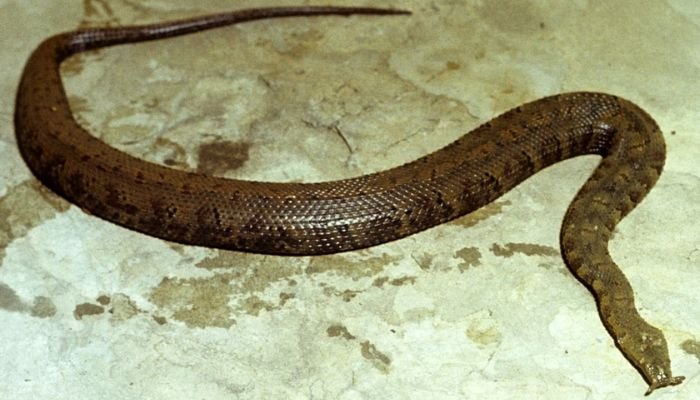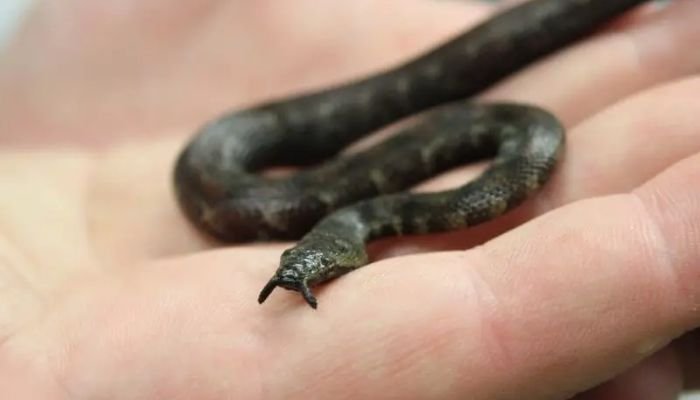The tentacled snake, or Erpeton tentaculatum, is a type of aquatic snake native to Southeast Asia that is both unusual and fascinating. The tentacle-like appendages that these snakes utilize to catch fish are a distinguishing feature of this species. Having a tentacled snake as a pet can be rewarding, but only if you’re willing to dedicate yourself to giving it the care and attention it deserves. In this article, we will explore “What Are the Key Considerations for Tentacled Snake Care?”
Natural Habitat and Behavior of Tentacled Snake
It is the slow-moving waters of Southeast Asia, especially in places like Thailand, Vietnam, and Cambodia, that are home to tentacled snakes. They have adapted well to living in the water, and you can find them in places like rice paddies, swamps, and marshes. Creating an appropriate environment for them in captivity requires an understanding of their native habitat.
Tentacled snakes spend the vast majority of their life in the water and are considered to be true aquatic species. The tentacles on their appendages help them detect prey by picking up vibrations in the water.
These snakes are nocturnal, meaning they are most active in the evening and early morning hours. Captive animals benefit from a day-night cycle that is consistent with their natural rhythms.
Tentacled snakes are solitary creatures that don’t need frequent contact with others of their kind. They become more agitated and aggressive when kept in groups or couples.
As a form of concealment and shelter, tentacled snakes often burrow in the mud and plants of their natural habitats. They will be grateful for places to hide and constructions that can be submerged while they are held captive.
What Are the Key Considerations for Tentacled Snake Care
Enclosure Setup
A proper habitat for your tentacled snake is essential to its well-being. The essential parts of a secure container are as follows:
- A single tentacled snake requires a tank or aquarium with a minimum capacity of 20 gallons. More swimming space is always a plus, therefore larger tanks are preferable.
- Keep the water in the enclosure clean and dechlorinated at all times. It needs to be deep enough to totally submerge the snake, yet shallow enough that it can readily come to the surface for air.
- Tentacled snakes thrive in dim lighting and warm temperatures. Keep the air at 75-80 degrees Fahrenheit (24-27 degrees Celsius) and the water at 78-82 degrees Fahrenheit (25-28 degrees Celsius). To create a warm area in the low 80s F (about 28-30 C), use a basking lamp. Since tentacled snakes spend most of their time under the water, they don’t need to be exposed to UVB rays.
- Create an environment similar to their native habitat by layering the bottom of the enclosure with fine sand or aquatic gravel. It is important to have a clean, debris-free substrate.
- Provide the snake with places it can hide when it needs some space or is feeling anxious, such as a PVC pipe or an underwater grotto.
- The addition of water plants, either real or fake, to the snake’s habitat serves as both a decorative accent and a source of enrichment.
- Maintaining high water quality requires the use of a filter system. It’s also important to replace the water frequently.
- Mist the cage frequently to keep the relative humidity high (between 70 and 80 percent). In doing so, you reduce your risk of dehydration and skin problems.
Feeding
Carnivorous in nature, tentacled snakes dine mostly on fish in the wild. Maintaining their natural diet in captivity is crucial to ensuring their well-being.

A tentacled snake’s food should primarily consist of guppies, minnows, and goldfish. Provide prey items that are about the same width as the snake’s body or slightly smaller.
- Younger snakes may need to be fed more frequently, usually every 7-14 days. Reduce feedings to every 10-14 days as they mature. If you want to keep the snake from choking on its meal, make sure it isn’t any wider than its head.
- Tentacled snakes have a novel feeding technique. Their tentacles are used to imitate the swimming motions of prey species. This provokes the snake to strike as the fish swims closer to inspect. Providing live or recently deceased fish is recommended because it can be difficult to mimic this behavior in captivity.
- Supplements of vitamins and minerals should be dusted onto prey items as needed to maintain adequate nourishment.
- Observe your snake regularly to track its growth and overall health. Both overfeeding and underfeeding can bring negative health outcomes.
Handling and Temperament
Snakes with tentacles are notoriously difficult to handle. They are often frightened and overwhelmed by too much social interaction. While minimal handling is preferred, the following criteria should be observed:
- Minimize unnecessary handling and only perform routine health checks or tend to the enclosure when necessary. No more than once a week should you handle your snake.
- Slow and careful motions are recommended when handling your snake. To ease tension, approach from below rather than above.
- If your snake starts breathing rapidly, taking defensive positions, or musking (producing a foul-smelling fluid), these are all signals that it is stressed and has to be returned to its enclosure.
- Avoid stressing the snake with your fragrance by washing your hands before and after handling.
Health and Veterinary Care
Maintaining top health for your tentacled snake requires regular checkups. Some suggestions for keeping your snake in good shape:
- Check for external parasites like mites and ticks on a regular basis. Seek the advice of a vet who specializes in treating reptiles if you suspect an infestation.
- Snakes with tentacles periodically shed their skin. Make sure there’s enough moisture in the air within the cage to make shedding easier. See a vet if the snake is having trouble shedding.
- Wheezing and other indicators of respiratory distress should prompt you to take a closer look. These may be signs of a more serious health issue.
- Schedule a yearly checkup with your reptile vet to make sure your snake is in good health.
- To prevent the transmission of disease to the rest of your collection, isolate any new snakes for a time after bringing them home.
Breeding Tentacled Snakes
Tentacled snake breeding can be a difficult but worthwhile task. Here’s a quick rundown of what happens:
- Tentacled snakes are notoriously tricky to sex. The average male is smaller and has a shorter tail than a female, who is normally larger and has a longer tail. They may be easier to sex for experienced breeders.
- Reduce the water temperature to about 70 degrees Fahrenheit (21 degrees Celsius) for a few weeks in the late winter or early spring to encourage breeding. To simulate the changing of the seasons, the water temperature should be brought back up to normal over time.
- When the time comes, place the male snake in the same enclosure as the female. As part of the courtship ritual, the male may trail the female or even rub up against her. Most mating takes place below the surface.
- The gestation period lasts between three and four months and begins after mating. Help her relax by giving her a calm space to be in for the time being.
- Tentacled snakes are ovoviviparous, which means they birth fully developed babies. Females typically only have two to five babies at a time, though reports of larger litters exist.
- Babies are on their own as soon as they are born. They can remain in one large enclosure for a short time, or you can divide them up into smaller ones.
Legal Considerations
You should research local ordinances regarding ownership of tentacled snakes before bringing one home. The ownership of some species of snakes may be illegal in some countries or jurisdictions. Make sure you’re following all applicable rules and regulations at all times.
Facts
[table id=29 /]
Conclusion
A Summary of Tentacled Snake Care
Tentacled snakes are fascinating animals, and knowledgeable reptile owners can enjoy having one as a pet. However, they have special nutritional requirements that must be met, as well as an aquatic environment that must be carefully maintained. You can give your tentacled snake a good life if you research its natural environment, build a suitable cage, and adhere to recommended feeding and handling practices.
When caring for these fascinating marine snakes, it is important to remember the value of consulting with knowledgeable reptile keepers and physicians. In this article, we have explored “What Are the Key Considerations for Tentacled Snake Care?” I hope you like it.

